|
|
|
Sort Order |
|
|
|
Items / Page
|
|
|
|
|
|
|
| Srl | Item |
| 1 |
ID:
176684
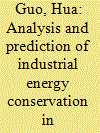

|
|
|
|
|
| Summary/Abstract |
As industrialisation continues to accelerate in China, underdeveloped regions are required to reduce their energy consumption. In this study, we examined industrial energy conservation in China's policy guidance and formulation, and the development of industrial energy conservation in the 12th Five-Year Plan period. Using a pre-processing grey model GM(1, 3), we forecast the energy consumption per unit of industrial added-values during the 2015–2020 period with higher accuracy than the untreated model. To comprehensively understand the energy consumptions of the primary products of six high energy-consuming industries, we established pre-processing GM(1,1) for the 2017–2024 period. The results show that the ecological development path not only promotes economic and industrial developments but also significantly reduces energy consumption. Moreover, the annual reduction rate of energy consumption per unit product is projected to be moderate during the 2015–2020 period than during the 12th Five-Year Plan period. Finally, we investigate and analyse the existing problems of industrial energy conservation and the development of the six industries. This study offers policy suggestions for industrial energy conservation in underdeveloped regions.
|
|
|
|
|
|
|
|
|
|
|
|
|
|
|
|
| 2 |
ID:
176718
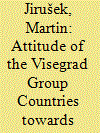

|
|
|
|
|
| Summary/Abstract |
The article analyses individual stances of the Visegrad Group countries (i.e. Czech Republic, Slovakia, Poland and Hungary) towards infrastructural projects in the natural gas sector currently being built by Gazprom, and determining factors influencing their respective attitudes. More specifically, the research focused on Nord Stream 2 and TurkStream, pipelines that aim at supplying Europe while circumventing traditional transit countries in the central and Eastern Europe, including the Visegrad group countries. The paper is organized as a series of individual case studies, each dedicated to one state under scrutiny. The author concluded that there is no common ground upon which a unified stance of the Visegrad Group could be formulated in this regard. Also, the states differ in adherence to theoretical attitudes to energy policy in general. Despite the declared unity, the Visegrad Group states pursue their own goals determined by economic interests or long-standing foreign policy stance. Consequently, central Europe is fragmented in its attitude towards the Russian infrastructural projects and thus more prone to penetration and individualized deals.
|
|
|
|
|
|
|
|
|
|
|
|
|
|
|
|
| 3 |
ID:
176659


|
|
|
|
|
| Summary/Abstract |
Electrical energy storage is often proposed as a solution for the mismatch between supply patterns of variable renewable electricity sources and electricity demand patterns. However, effectiveness and usefulness of storage may vary under different circumstances. This study provides an abstract perspective on the merits of electrical energy storage integrated with decentralized supply systems consisting of solar PV and wind power in a meso-level, residential sector context. We used a balancing model to couple demand and supply patterns based on Dutch weather data and assess the resultant loads given various scenarios. Our model results highlight differences in storage effectiveness for solar PV and wind power, and strong diminishing-returns effects. Small storage capacities can be functional in reducing surpluses in overdimensioned supply systems and shortages in underdimensioned supply systems. However, full elimination of imbalance requires substantial storage capacities. The overall potential of storage to mitigate imbalance of variable renewable energy is limited. Integration of storage in local supply systems may have self-sufficiency and cost-effectiveness benefits for prosumers but may have additional peak load disadvantages for grid operators. Adequate policy measures beyond current curtailment strategies are required to ensure proper distribution of benefits and responsibilities associated with variable renewable energy and storage.
|
|
|
|
|
|
|
|
|
|
|
|
|
|
|
|
| 4 |
ID:
176716
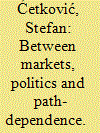

|
|
|
|
|
| Summary/Abstract |
This article contributes to the recent scholarly attempts towards bridging different energy studies perspectives in explaining the change of energy systems. Informed by political, socio-technical and techno-economic perspectives on energy transitions, we focus on explaining the divergent solar and wind power deployment rates across six Central and Eastern European countries. We suggest and test the proposition that the interplay of four key factors has shaped this development: state capacities, relations with Russia, technological lockin and electricity import dependency. We find that the countries relations towards Russia, the level of nuclear power lock-in and the state intervention in the energy sector have been instrumental in affecting the adoption of wind and solar power. The integrated framework and the findings presented in the article should encourage future energy transition research to capture and trace the interplay among different factors in an integrated and comparable manner.
|
|
|
|
|
|
|
|
|
|
|
|
|
|
|
|
| 5 |
ID:
176702
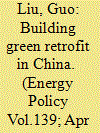

|
|
|
|
|
| Summary/Abstract |
Green retrofit is an effective way of improving the performance of existing buildings to achieve low energy consumption and low carbon emission. To realize a successful building green retrofit, it is important to understand the barriers and to develop relevant policies for retrofitting existing buildings, especially in developing countries. As a typical developing country, China has a large number of aged buildings with high green retrofit potential. In terms of its government structure, economic development, and building stocks, China is unique in that it poses a unique set of barriers and policy strategies on the promotion of building green retrofit. Based on a critical review, existing retrofit policies in China were reviewed. Then, the barriers to building green retrofit within the context of China were identified. Based on the study of existing policies and barriers, relevant policies for addressing these barriers are recommended. The findings provide a valuable reference for policy makers in China to review current building green retrofit policies or to develop new policies that address the barriers. This study also provides a useful reference for other countries aiming to review their building green retrofit policies.
|
|
|
|
|
|
|
|
|
|
|
|
|
|
|
|
| 6 |
ID:
176667
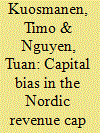

|
|
|
|
|
| Summary/Abstract |
Nordic energy market reform and the regulation of local monopolies in electricity transmission and distribution sectors have served as role models for many other countries worldwide. The first contribution of this paper is to clarify the conceptual distinction between the Nordic revenue cap approach and the British revenue cap regulation. Our second contribution is to show that the Nordic revenue cap is similar to the U.S.-style rate of return regulation in that both are subject to capital bias, known as the Averch-Johnson effect. The third contribution of this paper is to examine the magnitude of the capital bias and its welfare effects by means of numerical simulations. We show that the Nordic revenue cap generally decreases the monopoly profit, increases the output, decreases the price, and hence increases consumer surplus compared to the unregulated monopoly. The simulation results prove robust to changes in the parameter values and the functional form of the production function. Our numerical simulations reveal that relatively light handed regulation suffices to yield the main benefits.
|
|
|
|
|
|
|
|
|
|
|
|
|
|
|
|
| 7 |
ID:
176695


|
|
|
|
|
| Summary/Abstract |
There are overwhelming proofs that world-wide carbon emission profiles have been substantially shaped by carbon leakage through international trade. However, it has been unclear how structure and functions of the global carbon transfers evolve in terms of a complex network. Therefore, this study applies a series of network tools to depict the evolution features of the global carbon flow network from 1995 to 2011 as supported by a systems multi-regional input-output analysis. At global level, the network density increases essentially, indicating the widely expanding carbon leakages among economies. The increasingly distinct scale-free distribution for cumulative degree/weighted degree implies the network's intensified heterogeneity structure. At regional level, a new tripartite cluster structure has been identified by the three gradually stabilized communities centered on USA, China and Europe. At national level, the evolution for all economies' roles, especially two prominent groups (i.e. G8 and BRICS), is enunciated by coreness in context of the core-periphery structure, highlighting the significance of monitoring core economies' carbon emission flows. The results urge the need to shift from local carbon mitigation in silos to global collective and inclusive governance. Regional cluster structure's identification highlights the urgency for multinational cooperation on emission mitigation within the three newly formulated communities.
|
|
|
|
|
|
|
|
|
|
|
|
|
|
|
|
| 8 |
ID:
176707
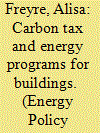

|
|
|
|
|
| Summary/Abstract |
Carbon tax is among the most intensively discussed topics in energy research and policy nowadays, but the question of using carbon tax revenue for environmental and energy policy purposes has received little attention so far. Currently the revenue generated from carbon tax has different usage in the countries worldwide, with only one quarter used for environmental and sustainable energy purposes. Against this background we study whether it can be advisable to use carbon tax revenue for financing energy efficiency and renewable energy (EERE) programs. Based on the case study of Switzerland, we demonstrate that such a policy approach could not only allow to achieve additional reduction of CO2 emissions, but also considerable net benefits to household sector with regard to reduction of heating costs, while having rather low program costs for individual households.
|
|
|
|
|
|
|
|
|
|
|
|
|
|
|
|
| 9 |
ID:
176685


|
|
|
|
|
| Summary/Abstract |
There is an ongoing reform in coal taxation in China, from a quantity-based to a price-based approach. While the coal tax could play an important role in resource conservation and air pollution reduction, its distributional effect is not well studied. This paper investigates the distributional effect of China's coal taxes on households before and after the reform. We find that about 30 percent of rural households and six percent of urban households are directly affected by the coal taxes, and that the directly affected households tend to be poor. We also find that provinces are affected differently by the coal taxes; the provinces that are more affected tend to have lower household income. By the Suits Index, we find that both the quantity-based and price-based coal taxes are regressive for residential consumers in China, and that the coal taxation reform had little effect on the regressivity of the coal tax. By simulation, we find that the regressivity of the coal tax could be reduced if the tax rate were set to be positively correlated with provincial household income.
|
|
|
|
|
|
|
|
|
|
|
|
|
|
|
|
| 10 |
ID:
176693


|
|
|
|
|
| Summary/Abstract |
In this paper, we develop a quantitative indicator approach including 20 indicators to measure the multiple benefits of energy efficiency (MB-EE). The MB-EEs are classified into three groups: environmental (e.g. energy savings, emissions), economic (e.g. GDP, employment), and social (health, energy poverty) aspects. We explain the methodological approach, the underlying data sources and limitations. The indicator set has been applied to 29 countries (EU28 plus Norway) for the period 2000 to 2015, proving that it allows to conduct in-depth comparisons of developments and differences across Europe. The indicator set also supports the design of well-suited energy policies by allowing to take into account, on an informed basis, more of the multiple impacts of energy efficiency.
|
|
|
|
|
|
|
|
|
|
|
|
|
|
|
|
| 11 |
ID:
176648


|
|
|
|
|
| Summary/Abstract |
The incorporation of the Internet of Things (IoT) technologies enables products with new features, thus turning them into “smart products.” One of the opportunities presented by the literature for these applications is the development of household smart meters. In spite of this, few studies in this area seek to understand the most appropriate configurations of smart meters to meet customer needs. With this in mind, the objective of this work is to identify the most appropriate configuration for a smart household meter for electricity, water, and gas consumption, which adds value for a different household customer. Therefore, a market research based on Conjoint Analysis Based on Choice was carried out. The survey presents a sample of 202 respondents restricted to the metropolitan area of Florianópolis, in southern Brazil. The results indicate the relevance given by sample consumers to energy and water control, but no significant interest in controlling gas consumption. Consumers are also interested in using the mobile application to access information and tips on the consumption of monitored resources. Moreover, respondents in this region are less price sensitive. However, women and consumers of cheaper real estate are more willing to pay a higher price for a smart meter.
|
|
|
|
|
|
|
|
|
|
|
|
|
|
|
|
| 12 |
ID:
176646


|
|
|
|
|
| Summary/Abstract |
As the world confronts the Covid-19 pandemic, we hope that all of you are doing well. We know that many lives have been greatly disrupted, and that world economic activity is slowing and maybe declining in some places. We have read reports that energy consumption has been greatly affected by the slowdown in world economic activity—likely contributing to the sharp plunge in oil prices earlier this year. We do not know how long this pandemic may last. As we look forward to the end of the pandemic and a recovering world economy, however, we wonder if and how energy systems may have to be transformed, and whether new energy policy needs and approaches will emerge. Will we see any change in the trajectory of adopting sustainable energy systems and reducing carbon emissions?
|
|
|
|
|
|
|
|
|
|
|
|
|
|
|
|
| 13 |
ID:
176686
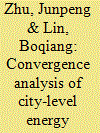

|
|
|
|
|
| Summary/Abstract |
Understanding the convergence patterns of energy intensity and the drivers leading to the club convergence are of great significance for local governments to implement targeted policies to improve energy efficiency. With this in mind, we begin with the collection of energy consumption data of 193 Chinese cities at prefecture level or above, then we adopt the log t-test and clustering algorithm to investigate convergence characteristics of energy intensity. Besides, the Ordered Probit model is adopted to investigate the drivers that affect the formulation of convergent club. We identify four convergent clubs among total 193 cities, and these clubs show great differences in energy intensity. Marketization degree, population density, foreign direct investment, resource endowment, and industrial structure are recognized as the drivers of the formation of convergence clubs. This paper adds more evidence to understand the energy intensity gap, we propose that upgrading the industrial structure, exerting economic assemble advantage, enhancing the level of opening up, and improving the marketization level are favorable measures to reduce energy intensity.
|
|
|
|
|
|
|
|
|
|
|
|
|
|
|
|
| 14 |
ID:
176692


|
|
|
|
|
| Summary/Abstract |
Economic cycles in the form of capacity utilization might greatly affect productivity. In order to explore how does carbon dioxide emissions reduction influence capacity utilization, this paper proposes a novel method to decompose the total capacity utilization (TCU) rate under carbon dioxide emissions reduction constraints using data envelopment analysis. The TCU rate is decomposed into an equipment utilization rate (EU), low-carbon technology efficiency (CTE), and policy oriented capacity utilization rate (PCU), and four policy orientations are then simulated to investigate the performance of TCU and its components. Three main conclusions are drawn: (1) the TCU rate was basically maintained between 60% and 70%, indicating a serious overcapacity in China. (2) most regions with a higher TCU rate are the well-developed southeast coastal regions, those with lower TCU rates being mainly the central and western regions; (3) the mandatory emission reduction mode is one of the main causes of overcapacity, where the southeastern coastal areas in particular suffer the most severe capacity loss. In comparison, a win-win development mode is the most cost-effective for China, with a relatively small capacity loss. These conclusions could assist policy designers in improving capacity utilization through effective low-carbon policies.
|
|
|
|
|
|
|
|
|
|
|
|
|
|
|
|
| 15 |
ID:
176654


|
|
|
|
|
| Summary/Abstract |
This study provides a comprehensive examination of factors that affect the electricity bill savings of a sample of solar adopters in four U.S. states. A multilevel model is used to capture the role of variations across state policies and local regulations, and examine their effect on savings after controlling for household characteristics. We find that solar adopters located in zip codes with higher photovoltaics penetration have significantly higher summer savings. This suggests that local policies that remove barriers for the wide adoption of solar panels across multiple households would be in alignment with increasing the private value of solar panels. Furthermore, we find that solar adopters in zip codes with smaller installed capacity have higher summer savings. The analysis in this study suggests that, to achieve higher savings, local policies that regulate size are less effective compared to policies that remove barriers to a wider photovoltaics adoption. Finally, this study finds evidence for the role of certain household-level variables in explaining the electricity bill savings of solar adopters. Solar-savings-calculators can be customized to include some of these house and resident characteristics.
|
|
|
|
|
|
|
|
|
|
|
|
|
|
|
|
| 16 |
ID:
176662


|
|
|
|
|
| Summary/Abstract |
Despite the relatively large number of gas stations reached in Spain after decades of sectorial reforms, pre-tax fuel prices in the country remain systematically among the highest in the EU. The literature provides evidence suggesting that a low intensity of competition in the retail distribution could contribute to these casual observations. With the purpose of shedding light on ways to design effective competition measures, we conduct an empirical analysis of more than ten million observations containing information about prices, brands, and locations at the station level. This allows us to know whether the exit (entry) of some classes of stations have the ability to reduce the prices of nearby competitors. Our results suggest that the presence in a local market of a station belonging to the network of the dominant market companies will tend to generate prices above the average. This is not only because these stations set higher prices but also because their presence will give rise to overpricing by local competitors. The opposite occurs with the self-advertised as “low-cost” stations. Policy measures promoting the gradual exit of stations associated with the dominant companies seem quite reasonable in view of the commitment to the transition toward transport decarbonization.
|
|
|
|
|
|
|
|
|
|
|
|
|
|
|
|
| 17 |
ID:
176655


|
|
|
|
|
| Summary/Abstract |
Over the last two decades, the European Union and its Member States have introduced policies aimed at improving energy efficiency. The Energy Service Directives (ESD) introduced the concept of measurement of energy savings attributed to policies. Two different and complementary methodologies for the evaluation of energy savings have been developed under the ESD: the bottom-up (BU) approach, based on a technical analysis of each measure, and the top-down (TD) approach, based on the analysis of how energy intensity changes over time. BU methods can hardly take into account policy-induced behavioural changes, whereas TD methods have difficulties in disentangling policy-induced savings from other savings. Econometric models have been proposed as a viable alternative to deal with both drawbacks. The purpose of this article is to present an econometric model aimed at estimating the energy savings induced by energy efficiency policies in the EU Member States in the period 1990–2013. We introduce an explicit measure of Energy Policy Intensity based on the MURE database, which is used as explanatory variable in a dynamic panel model for 29 European countries. Our results suggest that energy consumption in 2013 in Europe would have been about 12% higher in the absence of energy efficiency policies.
|
|
|
|
|
|
|
|
|
|
|
|
|
|
|
|
| 18 |
ID:
176652


|
|
|
|
|
| Summary/Abstract |
To date, research has mostly focused on the impact of energy efficiency on the total electricity demand but not on the electricity demand profiles. To address this gap, we estimate the impact of energy efficiency measures and policies such as minimum energy performance standards on the peak load by developing a bottom-up model that generates Swiss household hourly electricity demand profiles per appliance based on time use data. The model estimates that evening appliance peak demand can be reduced by 38% when the appliances are replaced by the highest energy efficiency label available on market. We find that changing light bulbs to LED would have the same peak reduction as switching cooking or wet appliances to off-peak periods throughout the year. We also show that the evening appliance peak demand could reduce in 2035 by 24% thanks to the improvement of the energy performance of the stock. Cooking appliances, the least favourable appliances to be involved in demand response, is expected to be the highest contributors to the evening peak in 2035. Our findings show that policy makers should pay due attention to energy efficiency improvement not only for reducing electricity demand but also in order to reduce peak load.
|
|
|
|
|
|
|
|
|
|
|
|
|
|
|
|
| 19 |
ID:
176697


|
|
|
|
|
| Summary/Abstract |
Grandfathering and benchmarking are two typical initial allowance allocation rules under the Cap-and-Trade (C&T) mechanism. They establish an emission limit which carbon emission generating enterprises is permitted. To avoid penalties caused by excessive emissions or to gain profits by selling saved portions of the allowance in the carbon trading market, enterprises can invest in green technology for achieving emission reduction which results in increasing cost and leads to a change in pricing strategies. This paper formulates mathematical models to quantify the optimal green technology investment and product pricing, and compare the effects of the two allocation rules on these operational decisions and total emission. The analytical results indicate that compared to benchmarking the optimal product price under the grandfathering rule is higher. Grandfathering will induce greater emission reduction. However, benchmarking is more likely to encourage enterprises to invest in green technologies for improving their energy efficiency. Moreover, the initial emission allowance under the grandfathering rule will not affect the green technology investment. However, the benchmark emission intensity will influence the green technology decision under the benchmarking rule. When choosing from two green technologies, investment in cleaner green technologies will not be authorized, in some instances, under a range of scenarios.
|
|
|
|
|
|
|
|
|
|
|
|
|
|
|
|
| 20 |
ID:
176696


|
|
|
|
|
| Summary/Abstract |
Despite the extensive use of demonstration projects, doubts remain on their effectiveness in promoting the commercialization of emerging technologies. To explore whether public demonstrations could stimulate innovation diffusion and to what extent the effects are, this paper conducted an empirical analysis of China's high-profile electric vehicle demonstration project based on a manually collected data set of 44 pilot cities from 2009 to 2015. The approach of difference-in-differences propensity score matching was used to address the selection bias of pilot cities, and the effects of demonstrating electric buses and electric commercial vehicles were further examined and discussed after a series of robustness check. The empirical results reveal that when controlling the impact of all policy incentives, the deployment of electric vehicles in the public sector has significantly stimulated the purchase of electric vehicles by individuals, especially in the pilot cities with more commercial vehicles, which provides new insights into the formulation of public procurement policies.
|
|
|
|
|
|
|
|
|
|
|
|
|
|
|
|
|
|
|
|
|